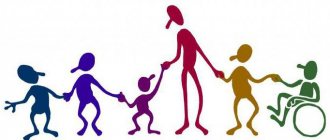The uniqueness of a person is determined not only by his inner world, but also by the totality of personality qualities that influence the individual’s attitude towards life and the people around him. To realize the uniqueness of each inhabitant of the Earth, it is necessary not only to know how personality traits are understood in psychology, but also to be able to notice the main individual psychological characteristics of a person.
Personality traits
Is a person a person?
Man is a creature that arose as a result of evolution, capable of living in society and conducting socio-historical activities. A person is constantly studying and changing the world around him, developing culture and building his own life.
Various sciences study the origin, development, and purpose of man in the world: religion, philosophy, psychology, biology.
Each person is an individual who has his own idea of the world, society, culture and activity.
Psychotypes according to Jung.
Jung divided personality types based on two general concepts: introversion or extroversion, as well as the main preferences of each personality type:
Condition 1. Where does a person get energy from?
An introvert is a person whose attention is directed inward; he receives energy from within. An extrovert's interest is directed outward; he receives energy from his environment. Condition 2
How a person accumulates knowledge. Methodically and scrupulously, based on facts, the sensory-sensing psychotype collects information. Intuitive people act mostly irrationally, based on the situation. Condition 3. How a person makes decisions. The thinking-logical type acts after an objective analysis of data. The emotional-feeling type makes decisions based on emotions, without unnecessary thinking. Condition 4. Concerns lifestyle. The rational type systematically implements the planned scenario. The perceiving type is often unpredictable, spontaneous, and flexible.
Based on the above conditions, Jung identified 8 psychotypes:
Is an individual a person?
An individual is a person who has an individual set of acquired and innate skills, abilities, and qualities. The individual is also recognized as a person as a separate representative of humanity, but these concepts still cannot be identified.
An individual is any representative of society, regardless of his social status, age and gender. High social organization allows an individual to cope with innate biological limitations, change behavior and control internal psychological processes.
A person is a person who knows how to build his own life line and controls behavior in order to achieve better results. Psychologists believe that an individual is able to become an individual only through constant communication with other people and leading an active social lifestyle.
Temperament
Continuing our consideration of the psychological properties of personality, we gradually approached temperament. Temperament conveys the dynamic characteristics of human behavior and activity. According to Pavlov, temperament is nothing more than an innate characteristic of the nervous system. In other words, genotype.
There are four types:
- Cholerics
In short, it is characteristic of those who are hot-tempered, unrestrained, impatient and impulsive. But at the same time, if they are met halfway, they can quickly “stabilize” their condition. They are characterized by persistence and stability in their interests and aspirations.
- Sanguines
It is typical for optimists and jokers. Sanguine people are sociable, which allows them to quickly build bridges of communication with other people. They can work a lot and for a long time. They take on new things easily.
- Phlegmatic people
It is quite difficult for them to rebuild in a new way and adapt to a new environment. They find it difficult to break old habits. They are slowly excitable, but at the same time they need a lot of time to “cool down”. With everything, phlegmatic people are quite energetic and efficient. They are characterized by endurance and self-control.
- Melancholic people
These are gloomy people with permanent internal tension. Their distinctive features: vulnerability, anxiety, restraint. Even minor difficulties can pull the rug out from under their feet, and they immediately give up.
Individuality is a distinctive feature of a person
Individuality is a set of human characteristics, qualities inherent in an individual person. The development of individuality is influenced by the family in which a person is raised, traditions and habits, relationships with parents, and worldview.
The manifestation of individuality is possible through appearance (manner of dressing, dyeing and styling hair, applying makeup, wearing jewelry, etc.), behavior, character, temperament.
What is it for?
Psychological portraits are used in their work by psychologists, psychiatrists, teachers, criminologists, and HR specialists. Each of them has its own approach to diagnosing the main parameters and its own tools.
They all also serve different purposes. Psychologists draw up a portrait to identify the client’s strengths and weaknesses, his internal contradictions, traumas and develop a strategy for solving problems. Teachers need it to choose the optimal teaching model. For criminologists - to better understand the identity of the criminal. HR specialists - to determine whether the applicant is suitable for the proposed position.
Why does an ordinary person, whose activity is not connected with any of these areas, need to draw up a psychological portrait? It would seem that no one can know a person better than himself. No matter how it is! Our perception of ourselves is greatly distorted. It is influenced by psychological defenses, false beliefs, childhood traumas and other psychological debris.
High-quality diagnostic techniques are able to bypass all these factors and produce the most objective and pure result. It can be used for the following purposes.
- Self-knowledge
A psychological portrait will allow you to look at yourself from the outside and see what was hidden from self-reflection. This will give you a bunch of new opportunities in terms of working on yourself.
- Career guidance
Not all people can easily decide on the choice of field of activity. But this is the most important and fateful choice in life. The happiness and well-being of a person depends on it. A psychological portrait will help determine in which types of activities you can reveal yourself best.
- Compatibility with people
When choosing a partner for life together or for business, it would be nice to get acquainted with his psychological portrait. This will help build harmonious relationships, correctly distribute roles, and avoid pitfalls during interaction. This approach may seem too pragmatic, but it really works.
- Effective business communication
Knowing the characteristics of your clients or partners, you can develop a strategy for mutually beneficial cooperation.
What qualities generally characterize a person?
When studying the topic, it is important to pay attention to what qualities best characterize a person?
Psychology identifies the following:
- The character of a person, which determines the manner of interaction with society and the world. Actions, habits, reactions to current events are manifestations of character and make a person individual. It is generally accepted that a person with a strong character is a strong personality. He achieves goals, high results and has a strong will.
- Willpower is the ability to control one’s own actions. A person who has this quality knows that if you want to achieve something, you need to do what you don’t always like. And he does. A person with a weak will does not.
- Emotional background – personal experiences of a positive or negative nature. This area includes mood, feelings, passion, stress and affect. The manifestation of emotions is individual: for some they are “turbulent” and loud, for others they are silent and unnoticed. In any case, the ability to manage your emotions is a very useful quality.
- Regulatory and incentive motivation. That for which a person performs actions. The main components of the concept: psychological or physiological need, incentive and intention to act/not act. Motivation is a powerful engine that forces a person to go towards a goal, solving difficult problems and overcoming himself. Knowledge about motivation can be successfully applied in your life, as well as used when communicating with other people or doing joint activities.
Emotions
Emotions are a mental reaction to any events. An emotional reaction is always subjective and has nothing to do with objective facts. Emotions are associated with the individual needs of the individual, as well as beliefs and experiences.
By type, emotions can be positive or negative. The first includes joy, passion, enthusiasm, faith, optimism, hope, satisfaction. The second - boredom, irritation, disappointment, anxiety, despondency, fear, sadness, excitement.
Psychologist B.I. Dodonov proposed the following classification of emotions according to the specifics of the situations in which they arise:
- communicative;
- altruistic;
- practical (occurs after the successful implementation of the plan);
- gloric (associated with the need for self-affirmation);
- fearful (occurs in situations of risk, danger);
- romantic;
- aesthetic;
- Gnostic (associated with the desire for knowledge);
- active (associated with accumulation, gathering);
- hedonistic (associated with any pleasures).
Emotions are situational experiences. They are short-lived. If you continue to experience the same thing after the situation ends, then this is the feeling. However, in practice, the first and second are often identified.
Psychology of Personality
Personality psychology studies directly a person, his personality and behavior. The definition of personality has several interpretations; psychology identifies various theories, concepts and hypotheses on this topic. Five personality theories are considered the most popular:
- Psychodynamic. Its main points were formulated by Sigmund Freud within the framework of classical psychoanalysis. He considered the main developing factor to be human instincts associated with life and death. Freud assigned an important place in personality development to sexual needs (libido). According to his theory, a person can go through the levels of personality development “it”, “I”, “super-ego”.
Character
Character is a complex of acquired personality traits. Don’t believe those who say: “That’s my character” or “We don’t get along.” Unlike temperament, character can be changed.
First, let's define the concept. Character is a complex of stable personality properties that determine a person’s behavior and reactions and his attitude towards other people and himself. Now let's look at several character classifications.
Classifications
S. Freud, within the framework of his theory of psychosexual personality development, identified the following types of character:
- Oral. This is an irritable person prone to overeating, alcohol abuse, smoking and other addictions. Among people of this type there are representatives of two subspecies: passive-oral and oral-aggressive. The first are distinguished by naivety, suggestibility, and knowledge. The latter are characterized by cynicism, often show aggression, crave power, and tend to manipulate people.
- Anal. These are overly pedantic, secretive people prone to hoarding. As with the oral character, there are two subtypes: anal-retentive and anal-thrust. People of the first type are distinguished by greed and stubbornness. People of the second type are characterized by emotional instability and an aggressive desire for leadership.
- Phallic. People of this type try to demonstrate their masculinity/femininity as much as possible in everything. And not in the best forms: impudence, bitchiness, depravity. These are people of extremes. They either hate themselves or they adore them; or remain faithful, or regularly engage in casual relationships; or are overly cautious, or lead a wild and dangerous lifestyle, etc.
- Genital. According to Freud, this is the optimal, healthy type of character. He is characterized by a high level of stress resistance, developed adaptive abilities, sociability, openness, and activity. Such people achieve success in all areas of life and know how to win people over.
Another psychoanalyst, Alexander Lowen, named these types of characters:
- Oral. These are people who depend on other people's opinions and are afraid of being rejected and abandoned. Every minute they demand attention to themselves, waiting for words of love. However, they do not know how to give off heat.
- Masochistic. These are secretive, distrustful and vindictive people, prone to self-punishment and self-flagellation. They are used to playing the role of a victim and suffering. Those who find themselves next to them become unwitting participants in some kind of drama.
- Hysterical. These are very artistic people. They do not live, but play on stage. Their every word, reaction, gesture is clearly verified and rehearsed. However, excessive emotionality prevents you from making and implementing long-term plans. Such people need emotions, so they constantly get into some kind of trouble, become participants or instigators of scandals and fights.
- Narcissistic. These are people who are guided solely by personal interests. People for them are tools, a means to achieve personal goals. A narcissist does not know how to empathize or sympathize. He asserts himself at the expense of others. He cannot stand loneliness, as he needs to see, hear and feel admiration for himself.
- Schizoid. People who live in their own world. Outwardly it seems that they are cold, callous, indifferent. But that's not true. Passions boil in the inner world of a schizoid; he knows how to love and get carried away by something. But he does not tolerate “water” or anything superficial. Carefully chooses friends, hobbies, and work.
I believe you have noticed that characters get their names from a set of individual, leading qualities. Therefore, sometimes character types are called accentuation types. But let's look at this separately.
Note! There are no bad or good characters. Each person has their own advantages and disadvantages.
Accentuations
Accentuations are sharpened character traits. That is, this is some kind of disharmony, in which some features are weakly expressed, while others are overdeveloped.
In psychology, it is customary to focus on the typology of accentuations proposed by A.E. Lichko:
- Hyperthymic type. These are resourceful, active and sociable people. They will make their way everywhere, however, problems arise with long-term planning. Risk-prone, rarely think about the consequences of their actions.
- Cycloid type. The life of such people consists of cycles: sometimes a good mood, sometimes a bad one, activity is replaced by passivity, a period of increased performance turns into a period of loss of strength, etc. If you communicate with this person occasionally, you may get the impression that you are dealing with different people. One phase of the cycle lasts 2–4 weeks.
- Labile type. Unpredictable and emotionally unstable type. Your attitude towards yourself, other people and the world is directly related to your mood. Increased sensitivity to external stimuli is noticeable.
- Asthenoneurotic type. An anxious, capricious, lethargic type, prone to hypochondria - excessive preoccupation with one's own health. Such people quickly get tired of work, communication and other activities.
- Sensitive type. These are sensitive and impressionable people. They prefer solitude, calm and quiet games, and “one-on-one” hobbies. In the presence of close people they behave relaxed, but in a circle of unfamiliar people they are reserved and indecisive.
- Psychasthenic type. These are anxious, suspicious, indecisive people, prone to philosophizing. They get tired quickly and suffer from mood swings. They often withdraw into themselves.
- Schizoid type. These people build an invisible wall between themselves and the world. They do not express the need for social contacts; they are happy alone. These are stubborn and purposeful people who do not like to pour water. The essence of things is important to them, not the form. Actions are preferred to words.
- Epileptoid type. This is a passive, inflexible type who is prone to affective outbursts. Moreover, in this case, the affect lasts quite a long time – up to several days. All this time the person is in a depressed mood and is looking for someone to take his anger out on. Epileptoids can be dangerous to others and are capable of violence during an outbreak.
- Hysterical type. Such people are characterized by egocentrism. They are indifferent to the problems and interests of others and crave constant attention to themselves. Prone to manipulation and blackmail, including demonstrative attempts at suicide.
- Unstable type. People of this type do not like to work, they try to escape from reality and responsibility into the world of entertainment and games. They cannot be alone. In companies they occupy the position of slaves.
- Conformal type. People of this type are afraid of novelty and do not perceive it in any form. They become attached to things, people, work, order, etc. They take a long time to get used to a new environment and have difficulty adapting to any changes in life. In a group, people are more likely to be followers than leaders.
You may have been confused by some of the names, as they are very similar to the names of mental disorders. Don't be alarmed. Accentuation is not a pathology. However, it cannot be considered normal either. This is a borderline state between the norm (a harmonious character in which all traits are balanced and compensate for each other) and pathology (psychopathy). Accentuations need to be monitored and, if possible, corrected, since under the influence of unfavorable factors they can turn into pathology.
Structure
Character structure is a group of leading traits. There is no generally accepted classification in psychology, but the following character structure can be roughly distinguished:
- emotional traits - cheerfulness or gloominess, sensitivity or callousness;
- volitional traits - decisiveness and indecisiveness, independence and dependence, initiative and passivity;/li>
- moral traits - kindness and cruelty, responsiveness and indifference, sincerity and deceit;
- intellectual traits - curiosity or indifference, intelligence or dullness, resourcefulness or confusion.
In everyday life, there are many unofficial names for characters: weak-willed (a rag), steely-willed (a man with a core), no character (a “neither fish nor fowl” person). All this has to do with character structure. That is, those around you notice which group of traits is expressed more strongly or weakly and, based on this, they give the name to the entire character. For example, the core refers to developed volitional qualities.
Personality structure
Personality structure is a set of unchanging qualities (emotions, character, willpower) that manifest themselves in different life situations. The listed components are also called personality traits and are divided into levels of development.
- Inferior . It is made up of innate properties, which include sexual desire and age-related characteristics.
- The second level, at which individual thinking, memory, perception, abilities, and attitude are observed. In addition to innate ones, this level includes acquired qualities and skills.
- The third level – taking into account individual experience based on acquired and developed knowledge, skills, and habits. The stage relates to social development and develops in the process of activity.
- Highest level. Individual direction of personality development, taking into account interests, drives, ideals, views, character. The development of the highest level is influenced by the upbringing and training of a person, his social environment.
Any personality structure has its shortcomings and positive sides. Knowledge of the basics of personality structure helps to establish social connections and promotes productive interactions between people.
Jung's typology
The basis for dividing people into psychological types is the tendency to predominantly direct vital energy (libido) outward to the situation or partners (extroversion) or to refrain from spending energy and influencing oneself from the outside (introversion). Hence the openness and sociability of pronounced extroverted types and the isolation and tendency to solitude of introverted psychotypes.
Both types of behavior are biologically based. In the animal world there are also two ways of adapting to the environment. The first, “extroverted” - the desire for unlimited reproduction in combination with the weak functioning of defense mechanisms (as in rats, rabbits, lice). The second, “introverted” - a small number of offspring with strong protective mechanisms (in most large mammals). Like animals, what an extrovert achieves through mass contacts with the outside world, an introvert achieves through a maximally independent position.
Carl Jung first introduced the concepts of extraversion and introversion as the main types of ego orientation. And later he supplemented his psychological typology with a description of four basic mental functions:
- thinking (logic);
- feeling (aesthetic judgments and ethical values);
- sensation (perception through the senses);
- intuition (unconscious perception).
Each of the basic psychological functions can be directed both outward and inward - the extraversion-introversion criterion. According to which of the functions is more developed (leading), the individual can be classified as a thinking, feeling, sensing or intuitive extrovert/introvert. The opposite of the predominant function is repressed into the unconscious and gives rise to interesting effects. For example, the thinking type does not like excessive displays of emotions, shouting, or pathos. But the “thinker” will receive the greatest pleasure from communicating with the emotional feeling type.
Personality traits
Personality properties include some phenomena that determine a person’s life activity and reveal his socio-psychological qualities. Psychologists refer to personality traits as such concepts as temperament, character, abilities, will, motivation and emotions.
Scientists consider abilities to be one of the key personality traits. For example, all people learn differently, and everyone has their own results of work or creative activity.
Abilities, according to psychologists, are rarely associated with knowledge and skills, but they qualitatively influence all processes of learning and development. There are some types of abilities:
- elementary or simplest, which are associated with the senses, movement and are innate;
- complex or socially conditioned, which are associated with certain areas: music, art, mathematics;
- general (motor, mental) - those that, in principle, all people have, but the level of their development is individual for everyone. This type of ability affects the level of a person’s achievements in the field of sports, scientific Olympiads and intellectual competitions;
- special abilities, the development of which requires a special inclination - artistic, musical, mathematical, acting. This explains the fact why, for example, some students in art schools draw better than others (the existing inclinations for art allow the skills to develop faster);
- theoretical and practical, allowing you to correctly set tasks, goals and take actions to achieve them;
- educational – contributing to the achievement of success in learning; creative, allowing you to create works in the field of art and spiritual culture;
- communicative. They are associated with the ability to establish contacts and interact in society, develop interpersonal relationships;
- subject-activity, relating to the interaction of a person and an inanimate object.
Individual ability levels are assessed in three degrees: giftedness, talent and genius. The process of developing abilities is strongly influenced by the type of temperament identified in a person.
Melancholic people, for example, have an increased level of anxiety and react painfully to criticism, and are prone to apathy and depression.
Cholerics are quick-tempered and impulsive, capable of quickly losing their temper and also quickly calming down.
Phlegmatic people are calm and balanced, they know how to do their work well and efficiently, but they have difficulty getting used to everything new.
Sanguine people (for the most part) are strong and optimistic people who know how to see positive qualities in everything.
Antique typology
Even before Theophrastus, Hippocrates created the doctrine of the internal juices (or liquids) in the human body. This is: yellow bile (lat. cholos),
black bile (lat.
melas cholos),
blood (lat.
sanguis)
and mucus (lat.
phlegma)
. From the four main juices he derived four temperaments:
- Choleric (mood changes strongly and quickly, tense, mental states are directed primarily outward).
- Melancholic (the mood is strong, but changes slowly, tense, mental states are directed mainly inward).
- Sanguine (mood changes slightly and quickly, is not tense, mental states are directed primarily outward).
- Phlegmatic (mood changes slightly and slowly, is not tense, mental states are directed primarily inward).
Personality Traits
Personality traits generally determine a person’s character, behavior and individual qualities. The following features and their meaning are distinguished:
- communicative : human interaction with others,
- business : attitude towards work and other activities,
- strong-willed : the ability to be persistent, purposeful,
- motivational : encouraging action,
- instrumental : giving individual style.
Focus
Perhaps one of the main psychological properties of a person is direction. It includes such important components as:
- Needs
- Motives
- Goals
In fact, direction is nothing more than their unity, which determines the nature of the individual’s activity.
In turn, needs represent the need of a person - if we consider it from the point of view of a socio-biological being in a formed material or spiritual object.
As you know, needs require satisfaction. This is what motivates a person to the necessary activity, which implies a certain activity.
Strong personality: examples of world famous people
Strong personality: what examples are known? History knows many people who turned the course of development of countries, influenced the development of socio-economic and cultural processes.
- Genghis Khan. A man of iron grip and strict discipline. Only thanks to his personal qualities was he able to conquer many states and create a powerful empire.
- Napoleon Bonaparte. A man who does not have outstanding external characteristics, but through perseverance and purposeful actions achieved the strengthening of France on the world stage and the conquest of many states.
- Peter I. The Russian emperor, who managed to introduce many innovations in Russia. Hard work, discipline, and adherence to principles in state matters and affairs allowed Pyotr Alekseevich to make Russia a strong world power, to conquer strategic access to the seas and to subjugate a number of foreign border cities. Under Peter the Great, the Russian army and navy received worldwide recognition.
- Catherine II. A German princess who managed not only to take the throne of the empress, but also to bring Russia forward economically at the global level. Having fallen in love with a foreign country and people, Ekaterina Alekseevna entered Russian history as the Great Empress.
- Nick Vujicic - a person with a complex disease, without limbs, but who managed to achieve a lot in life. Nick is the author of books on self-improvement, an excellent speaker and business coach, occupying the top lines of the rating of successful people of our time.
- Vladimir Putin – one of the strongest figures in world politics.
Discipline, self-analysis and self-development are the main qualities that influence the formation of personality. Strong individuals are able to change their lives for the better; they know what they want and systematically act towards their goal.
Modern problems of psychological classifications
Problems of psychological classifications are associated with the high complexity and ambiguity of mental reality. It is much easier to classify the material world.
In psychology we are faced with the fact that with the help of consciousness we can study consciousness. Here new opportunities open up, but also new limitations associated, in particular, with subjectivity and its overcoming. As is known, in the human psyche there are conscious and unconscious components of cognition. They often work independently, as two different assessors of the situation. Therefore, assessments using projective tests (which are aimed at exploring the unconscious) often conflict with self-assessments using questionnaires (which appeal to consciousness or conscious behavior).
To assess a psychological type, it is important that the measuring instrument (test, technique) be “calibrated” not for the present and relevant, but for the typical, more likely to be repeated throughout life. That’s why methods that allow typologists to see the present through the prism of an individual’s entire life journey are so important: biographical, structured conversation, longitudinal observation in a natural situation
Such methods are well developed in clinical research. When working with healthy people, they are rather the exception.
Example:
Personality research program of Lazursky A.F.
The issue of training a qualified specialist in the field of research and diagnosis of types is an independent problem. You need a whole range of knowledge and skills.
of the diagnostician is important for measuring psychological type.
to see not individual fragments of mental reality, but to operate with systems (cognitive, value-motivational, emotional, volitional) and take into account their holistic nature, knowledge of stable variants of these systems, and the ability to compare them. Comparing and evaluating these systems is complicated by the lack of a well-developed methodological framework: there is no consensus on what to compare and how to evaluate.
To the researcher
it is necessary to be able to work with both qualitative and quantitative methods of studying empirical reality, taking into account the following factors:
- The scale and complexity of the study (the ability to draw and take into account several plans at different scales)
- The nature and specificity of the distribution of properties and characteristics in the environment under study.
- A minimum set of subscales that do not violate the completeness and construct validity of a psychological property.











